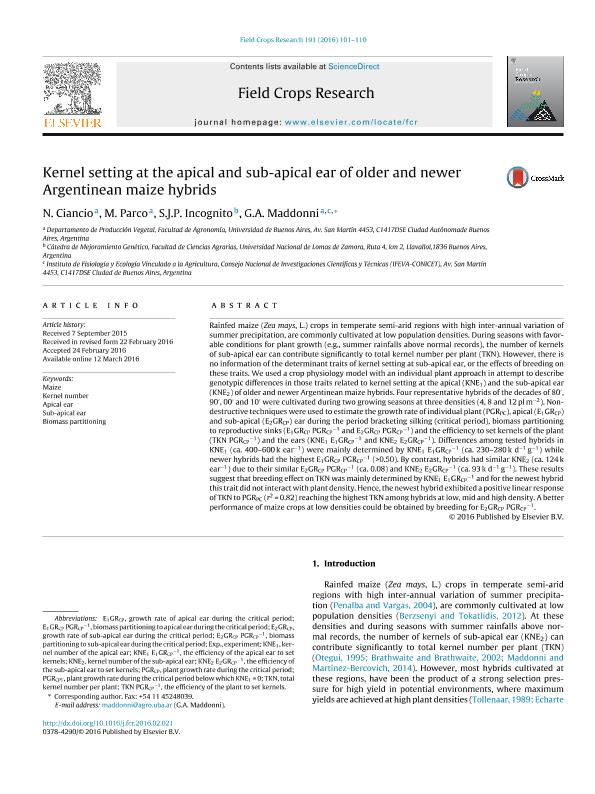Artículo
Kernel setting at the apical and sub-apical ear of older and newer Argentinean maize hybrids
Fecha de publicación:
05/2016
Editorial:
Elsevier Science
Revista:
Field Crops Research
ISSN:
0378-4290
Idioma:
Inglés
Tipo de recurso:
Artículo publicado
Clasificación temática:
Resumen
Rainfed maize (Zea mays, L.) crops in temperate semi-arid regions with high inter-annual variation of summer precipitation, are commonly cultivated at low population densities. During seasons with favorable conditions for plant growth (e.g. summer rainfalls above normal records), the number of kernels of sub-apical ear can contribute significantly to total kernel number per plant (TKN). However, there is no information of the determinant traits of kernel setting at sub-apical ear, or the effects of breeding on these traits. We used a crop physiology model with an individual plant approach in attempt to describe genotypic differences in those traits related to kernel setting at the apical (KNE1) and the sub-apical ear (KNE2) of older and newer Argentinean maize hybrids. Four representative hybrids of the decades of 80´, 90´, 00´ and 10´ were cultivated during two growing seasons at three densities (4, 8 and 12 pl m-2). Nondestructive techniques were used to estimate the growth rate of individual plant (PGRPC), apical (E1GRCP) and sub-apical (E2GRCP) ear during the period bracketing silking (critical period), biomass partitioning to reproductive sinks (E1GRCP PGRCP-1 and E2GRCP PGRCP-1) and the efficiency to set kernels of the plant (TKN PGRCP-1) and the ears (KNE1 E1GRCP-1 and KNE2 E2GRCP-1). Differences among tested hybrids in KNE1 (ca. 400 to 600 k ear-1) were mainly determined by KNE1 E1GRCP-1 (ca. 230 to 280 k d-1 g-1) while newer hybrids had the highest E1GRCP PGRCP-1 (> 0.50). In contrast, hybrids had similar KNE2 (ca. 124 k ear-1) due to their similar E2GRCP PGRCP-1 (ca. 0.08) and KNE2 E2GRCP-1 (ca. 93 k d-1 g-1). These results suggest that breeding effect on TKN was mainly determined by KNE1 E1GRCP-1 and for the newest hybrid this trait did not interact with plant density. Hence, the newest hybrid exhibited a positive linear response of TKN to PGRPC (r2 = 0.84) reaching the highest TKN among hybrids at low, mid and high density. A better performance of maize crops at low densities could be obtained by breeding for E2GRCP PGRCP-1.
Palabras clave:
APICAL EAR
,
BIOMASS PARTITIONING
,
KERNEL NUMBER
,
MAIZE
,
SUB-APICAL EAR
Archivos asociados
Licencia
Identificadores
Colecciones
Articulos(SEDE CENTRAL)
Articulos de SEDE CENTRAL
Articulos de SEDE CENTRAL
Citación
Ciancio, Nicolás; Parco, Martín; Incognito, Salvador Juan Pablo; Maddonni, Gustavo Angel; Kernel setting at the apical and sub-apical ear of older and newer Argentinean maize hybrids; Elsevier Science; Field Crops Research; 191; 5-2016; 101-110
Compartir
Altmétricas




